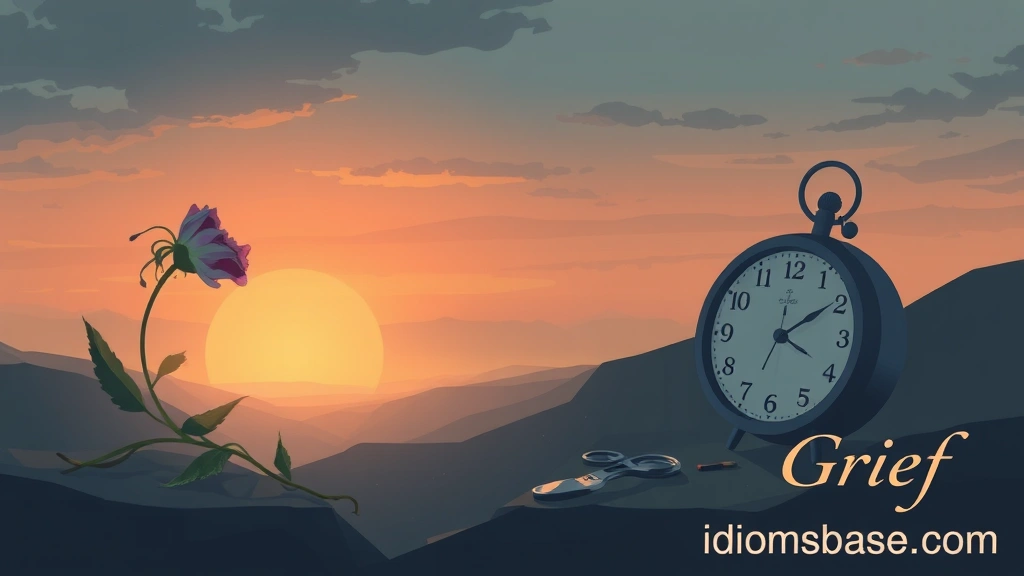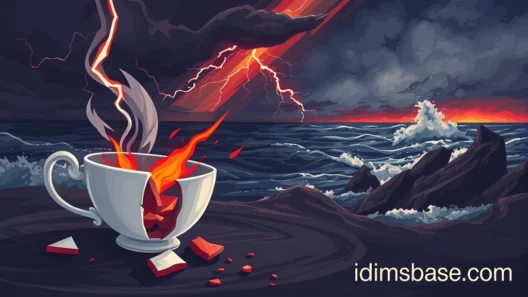Grief. It's a word that carries such immense weight, isn't it? When we experience loss, whether it's a loved one, a dream, or even a way of life, finding the right words to describe the swirling emotions can feel impossible. Language often falls short, leaving us grasping for something, anything, that truly captures the depth of our pain and confusion.
That's where metaphors come in! These beautiful linguistic tools allow us to paint a picture, to connect an abstract feeling to something tangible and relatable. They offer a pathway to understanding, not just for ourselves, but for others who might be struggling to comprehend what we're going through. Join us as we explore 38 powerful metaphors for grief, each offering a unique lens through which to view this complex human experience.
Why Do We Need Metaphors for Grief?
You might be wondering, "Why bother with metaphors? Isn't grief just… grief?" And that's a perfectly valid thought! But here's the thing: grief isn't a single, uniform experience. It's a kaleidoscope of emotions, sensations, and challenges. Metaphors help us:
- Express the Inexpressible: Sometimes, words just aren't enough.
- Find Connection: When someone else uses a metaphor that resonates, it makes us feel less alone.
- Process Our Emotions: Giving a name or an image to what we feel can help us understand it better.
- Communicate with Others: It provides a common language for discussing a difficult topic.
Ready to dive in? Let's explore these evocative descriptions.
38 Metaphors for Grief
Here's a collection of metaphors that beautifully illustrate the many faces of grief. As you read through them, see which ones resonate most with your own experiences or observations.

- Grief is a heavy cloak: It weighs you down, making every movement an effort.
- Grief is an ocean: Its depths are vast and unpredictable, with waves that can engulf you.
- Grief is a broken mirror: Your world is shattered into jagged pieces, reflecting a distorted reality.
- Grief is a phantom limb: You feel the presence of something that is no longer there, a deep ache for what's lost.
- Grief is a storm: It rages with wind and rain, leaving destruction in its wake, but eventually, it passes.
- Grief is a journey: A winding, unpredictable path with no clear destination, full of unexpected turns.
- Grief is a thief: It steals your joy, your peace, and sometimes, even your sense of self.
- Grief is a wound: It's raw and painful, needing time and care to heal, and often leaves a scar.
- Grief is a fog: It clouds your mind, making it hard to see clearly or think straight.
- Grief is a shadow: It follows you everywhere, a constant presence even on the brightest days.
- Grief is a labyrinth: You wander through its winding corridors, searching for an exit that seems elusive.
- Grief is a hollow ache: An emptiness inside that seems impossible to fill.
- Grief is a tight knot: It constricts your chest, making it hard to breathe.
- Grief is a rollercoaster: Tumbling highs and devastating lows, with sudden drops and unexpected twists.
- Grief is a cracked foundation: The very ground you stand on feels unstable and precarious.
- Grief is a wildfire: It consumes everything in its path, leaving behind scorched earth.
- Grief is a constant companion: It walks beside you, sometimes silently, sometimes loudly.
- Grief is a dull throb: A persistent, underlying pain that never quite goes away.
- Grief is a heavy anchor: It holds you down, preventing you from moving forward.
- Grief is a puzzle with missing pieces: You try to put your life back together, but some parts are simply gone.
- Grief is a bridge washed away: The connection to your past self or a loved one is suddenly severed.
- Grief is a garden choked with weeds: Your inner landscape feels overgrown and neglected.
- Grief is a record stuck on repeat: The same painful thoughts and memories play over and over.
- Grief is a silent scream: The pain is so immense, it feels inexpressible, yet you yearn to release it.
- Grief is a cold embrace: It chills you to the bone, leaving you feeling desolate.
- Grief is a broken melody: The harmony of your life is disrupted, leaving discordant notes.
- Grief is a buried treasure: Though painful, it can reveal hidden strengths and insights.
- Grief is a shapeshifter: It changes its form, appearing differently each day.
- Grief is a test of endurance: It pushes you to your limits, revealing your resilience.
- Grief is a transformative fire: While painful, it can purify and lead to growth.
- Grief is a mosaic in progress: You slowly piece together a new life, incorporating the broken fragments.
- Grief is a quiet whisper: It reminds you of what was, softly, persistently.
- Grief is a raw nerve: Every touch, every sound, can feel amplified and painful.
- Grief is a deflated balloon: All the air, all the joy, has seeped out.
- Grief is a knot in your stomach: A constant feeling of unease and anxiety.
- Grief is a bookmark in time: It marks a distinct "before" and "after" in your life.
- Grief is a ghost: The presence of what's lost lingers, unseen but felt.
- Grief is a seed: Planted by loss, it can eventually blossom into new understanding and empathy.
Understanding Your Own Grief
It's important to remember that your grief is unique to you. What one person experiences might be completely different from another's. There's no right or wrong way to grieve, and there's certainly no timeline. Be kind to yourself. Allow yourself to feel whatever comes up, and know that it's okay to seek support.
Key Takeaways

- Metaphors provide a powerful way to understand and communicate the complex experience of grief. They offer imagery that helps bridge the gap between abstract emotion and tangible understanding.
- Grief is multifaceted and highly personal. No two experiences are exactly alike, and metaphors help us acknowledge this diversity.
- Using metaphors can aid in processing emotions. Giving a name or an image to feelings can make them feel less overwhelming and more manageable.
- There is no "right" way to grieve. Be patient and compassionate with yourself as you navigate your own journey.
- Support is crucial. Don't hesitate to reach out to friends, family, or professionals if you're struggling.
Frequently Asked Questions
Q1: What is the purpose of using metaphors for grief?
Metaphors for grief serve several important purposes. They help us to articulate emotions that are often too overwhelming or abstract to put into direct words. By comparing grief to something more tangible (like an ocean or a heavy cloak), metaphors can make the experience more understandable, not just for the person grieving but also for those trying to support them. They can also offer comfort by showing that others have experienced similar feelings, fostering a sense of connection and reducing feelings of isolation.

Q2: Can metaphors help with the healing process?
Absolutely! While metaphors don't magically make grief disappear, they can be a valuable tool in the healing process. By providing a framework for understanding and expressing complex emotions, they can help you to process your feelings more effectively. When you can name or visualize what you're feeling, it often becomes less overwhelming. This can be a crucial first step towards acceptance and finding ways to cope.
Q3: Are there any "bad" metaphors for grief?
Generally, there aren't "bad" metaphors, but some might be less helpful or resonate less with individuals. A metaphor that feels dismissive, overly simplistic, or minimizes the pain of loss might not be beneficial. For example, comparing grief to "just a bad mood" would likely be unhelpful. The most effective metaphors are those that acknowledge the depth, complexity, and individuality of the grieving process. What resonates with one person might not resonate with another, and that's perfectly okay.
Q4: How can I use these metaphors to help someone else who is grieving?
When supporting someone who is grieving, you can gently offer these metaphors as a way to open a conversation. You might say, "Some people describe grief as a heavy fog that makes it hard to see. Does that resonate with how you're feeling?" This approach can give them a language to describe their experience without putting pressure on them to explain everything. It shows empathy and a willingness to understand their unique pain. Just be sure to listen more than you talk and validate their feelings, whatever they may be.
Q5: Is it normal for my experience of grief to change over time?
Yes, it is absolutely normal for your experience of grief to change over time. Grief is not a linear process; it's often described as a journey with twists, turns, and sometimes even steps backward. The intensity might lessen, or it might reappear in waves. The metaphors themselves highlight this dynamic nature – from a "storm" that eventually passes to a "shapeshifter" that changes its form. As you move through your grief, your emotions, coping mechanisms, and even your understanding of your loss will evolve. Be patient with yourself through these changes.






